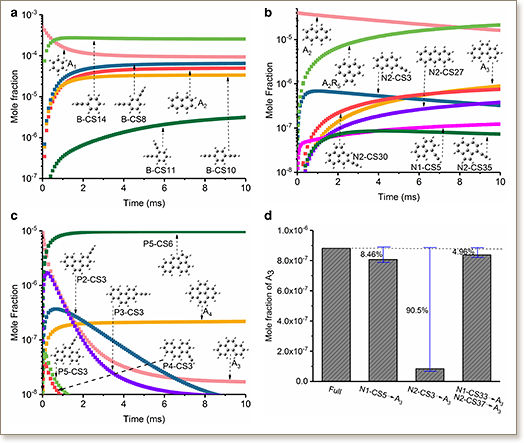The site effect on PAHs formation in HACA-based mass growth process

The site effect on PAHs formation in HACA-based mass growth process
P. Liu, Z. Li, A. Bennett, H. Lin, S.M. Sarathy, W.L. Roberts
Combustion and Flame, 199, pp. 54-68, (2019)

Hydrogen-abstraction/acetylene-addition (HACA) pathway has long been postulated as the dominant pathway for the formation of polycyclic aromatic hydrocarbons (PAHs) and the surface growth of soot. In this study, the site effect on PAH formation following HACA pathway is systematically investigated using density functional theory, transition state theory and premixed flame kinetic modeling. The entire reaction network includes 186 elementary reactions, starting from benzene to pyrene. Analysis of the potential energy surface and kinetic parameters show that H abstraction and C2H2 addition reactions are greatly sensitive to the site position (ortho-, meta- and para-position) relative to the existing C2H chain and surface site type (zig-zag, free-edge and armchair). Specifically, H abstraction and C2H2 addition reactions on the ortho-position and armchair surface site are kinetically unsupported due to the relatively high energy barrier and orientation hindrance effect compared with other site options. Therefore, the formation of a new benzene ring by the addition of the second C2H2 molecule on the ortho-position (e.g., 1-ethynylnaphthalene + C2H2→phenanthrene) or the first C2H2 molecule on the armchair surface site (e.g., phenanthrene + C2H2→pyrene) is unlikely, as demonstrated by PAH simulations in a premixed C2H4/O2/N2 sooting flame. The yield distribution of various reaction products has been investigated using a 0-D reactor, where the combustion conditions are taken from experimental data. The results show that the dominant products are di-substituted PAHs in benzene-naphthalene reaction system and PAHs with 5-membered ring structures in larger PAHs reaction systems. The existence of abundant PAHs with 5-membered rings contributes to clarifying the PAHs signal detected using laser induced fluorescence technology. Additionally, the observed sequence of mass peaks at intervals of mass number 26 in C2H2/C2H4 pyrolysis is reasonably explained by the HACA pathway with considering site effect.

"KAUST shall be a beacon for peace, hope and reconciliation, and shall serve the people of the Kingdom and the world."
King Abdullah bin Abdulaziz Al Saud, 1924 – 2015
Thuwal 23955-6900, Kingdom of Saudi Arabia
© King Abdullah University of Science and Technology. All rights reserved